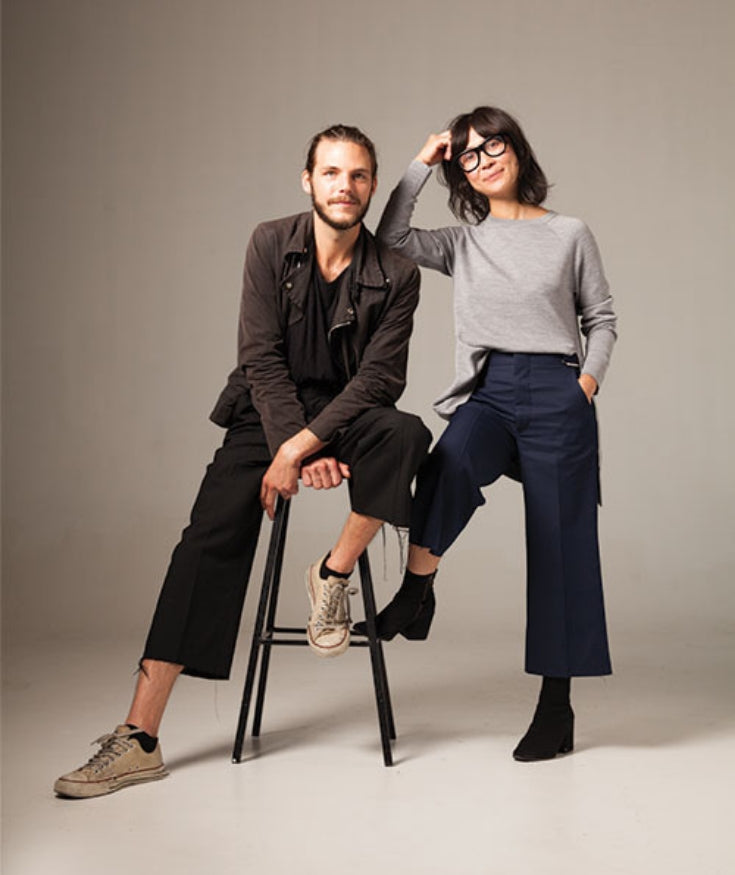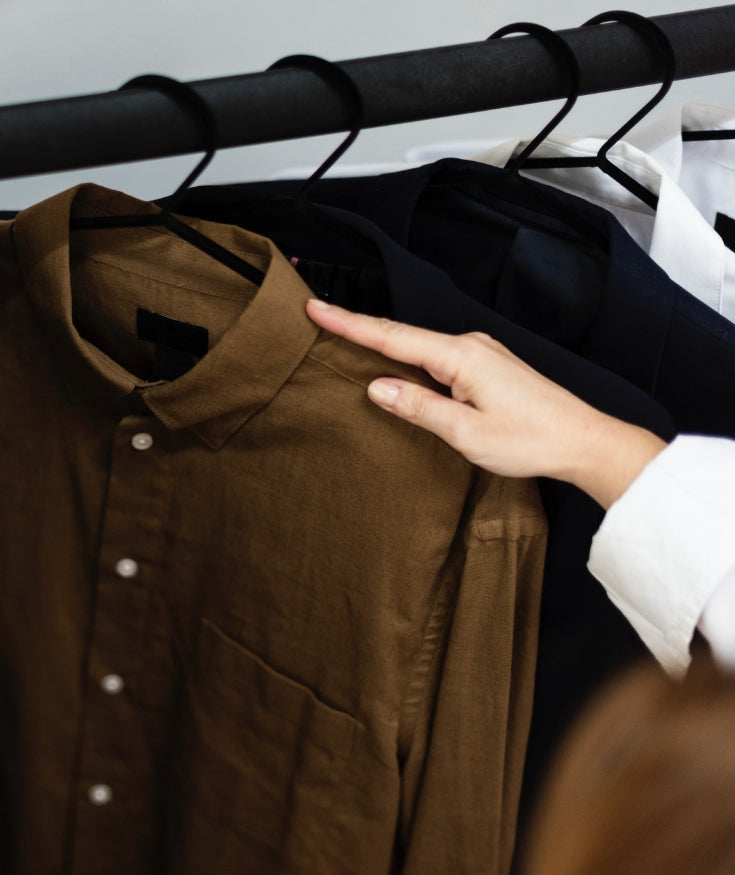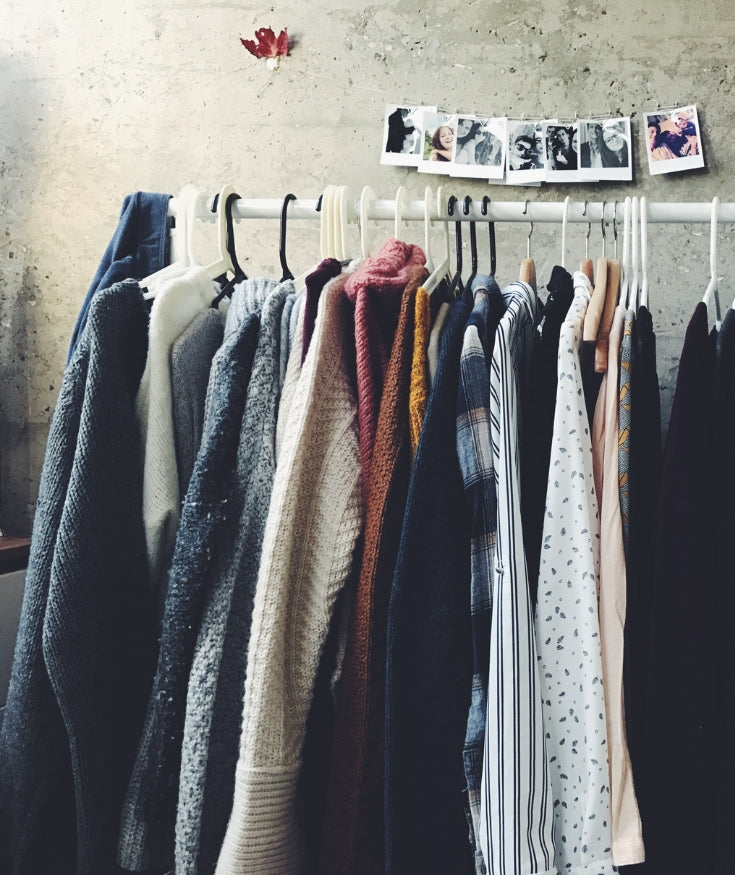How to Excel at Buying Recycled: An interview with the founders of Cuniform
Americans Christine Tran and Colton Dixon Winger have achieved creative independence that supports their goals and aspirations while helping like-minded clients reach their own. With 20+ years of experience in luxury fashion between them, they met, became fast friends, and then talked and drank coffee until deciding to launch their own agency, Cuniform, that would change the way people dressed themselves. They envisioned a path away from fast fashion, and toward one that is affordable, individual, beautiful, and sustainable. Their mission is to teach ethical wardrobe building skills to anyone who struggles with overstuffed and under-curated closets, regardless of income.
I met with Christine and Colton one cool Northwest morning to talk about their wholly unique approach to fashion and why buying recycled works for everyone.

Let’s start with where you’re from, and what the career path was that led to establishing your eco-minded styling agency?
Colton Dixon Winger: I’m from eastern Washington. I spent my early career at the American department store Nordstrom, first in Spokane, then in Seattle. Then I went to specialty boutiques in San Francisco and New York City where I did everything from merchandising to branding to events.
Eventually, Christine and I met when we were both working at luxury retailer Totokaelo, based in Seattle. But even by then I’d started growing tired of chasing the dollar sign and selling people clothes that I wasn’t sure they needed.
By the time I hit ten years, I thought I was done with fashion, ready for the next thing. Then Christine and I learned that – at different locations – we’d coincidentally resigned from the same company on the same day and for the same reasons. That kind of bonded us and that’s where the conversation started.
We wanted to be farmers, I was interested in running a commune, also, because I love dogs, I thought why not a dog farm? And then we realized we didn’t know how to do any of those things, and it would be a very big transition to make. That made it easier to see that we still had legitimate places to go with our talent in the fashion industry. So although we’ve stayed in fashion, we’ve moved away from promoting the retailer’s goals and towards promoting our own.
Christine, what is your story? Where are you from?
Christine Tran: I’m from just outside Seattle but grew up in many places. For school I got a liberal arts degree and then, because my dream was to teach, I got an MFA in darkroom photography. Turns out that darkroom photography was a dying industry! And unfortunately, digital wasn’t fun for me. So why would I learn something entirely new that I didn’t enjoy? Of course, I still needed a job, so that’s when I started working in a clothing boutique in Seattle.

Looking back to where you started, what is your biggest take away from the retail world?
CDW: For me, it was noticing how much of the work was about a conversation. Maybe someone needed new sneakers, or a dress for a birthday the next day, and we were talking and having an exchange about that.
CT: Right. What Colton and I each learned in luxury retail was that this work was an opportunity to have real conversations with real people. It’s relational based. And we loved these authentic relationships we had with customers.
CDW: We wanted to be able to be more truthful in those conversations though. We wanted a platform to be able to say all the things we wanted to say, like “I’ve known you for five years and you don’t really need this $14,000 jacket.” So we founded Cuniform.
When establishing Cuniform, why did you decide to set your fee according to the client’s income bracket? (aka sliding scale)
CT: We all experience needing help. Having a stylist is often seen as something for celebrities and people with very high incomes, but we wanted to work with everyone so we chose the sliding scale model.
CDW: Also, Christine and I are “normal people” in that way. We wanted to help regular people just like us in addition to the people that make up a more typical clientele.
Speaking of clientele, what are the most common sustainable fashion mistakes people make?
CDW: I see people do this all the time: Once they find something that works, they buy the same thing over and over again, just to have it, which limits versatility. And of course it’s the opposite of buying something once. So yeah, repeat purchases. Additionally, fit is a very common problem. Clothing is produced so quickly now that good fit doesn’t happen like it should.
CT: I agree. So my suggestion is to take a photo of yourself in the clothing, that way you can see something different than what is in the mirror. Friends don’t always know what to say, so take a few photos from different angles and judge for yourself. Still, if you can – and this isn’t always easy – try to find someone you trust, someone who will give you a personalized answer specifically for you.

Was there an eye-opening moment that made you care about sustainable fashion?
CDW: Yes. For me it was the 2013 collapse of the Rana Plaza factory in Bangladesh that killed over 1,000 clothing workers. That was when we all, as a society, saw the reality of low-cost clothing.
CT: I have an art background, and I have a lot of maker friends, so meeting the designers and supporting them as they make intentional, long-lasting clothing was a worthy thing, and I wanted to work with them in a tangible way. To me, that made sense.
Do you have any eco fashion heroes?
CDW: My heroes are outside of fashion. That’s because the fashion industry and all its manufacturing is so unbelievably complicated that it’s impossible to know for sure if the integrity is there or not.
CT: True. There are people and brands in the industry whom we celebrate though, such as Eileen Fisher, Everlane, and Older Brother, mostly for their production transparency. Also, Rachel Comey has her clothing produced ethically in New York which we like, and Eileen Fisher sells their recycled clothing.
Speaking of, what is the biggest misconception around recycled clothing
CDW: What I get a lot is people thinking it’s dirty and it’s ugly. Historically people have only given away old clothing or junk. But these days we are pumping more out into the world and there are beautiful things that get shared. People don’t realize this until we tell them.
CT: Clients tell me sometimes that recycled clothing was what they wore when they were just starting out, but now they are in a different phase of life and they don’t have to “do that” anymore. They have an association with recycled clothing being for the young.
What are your top tips for buying recycled clothing?
CDW: People should stay away from synthetic fabrics. Natural fibers are more attractive and feel better to wear. They are made to withstand weather and nature for example, so even when recycled, they are just better.
CT: There is more dimension to natural fabrics. They drape better, last longer, hold color better.
CDW: And again, fit is important so make sure you have the time to analyze fit when trying on recycled items. Take your time and don’t compromise on how something fits or you will buy a bunch of stuff you won’t want.
CT: I always recommend that someone think of three different ways that they will wear an item. If they can think of three things to go with it, that’s proof that the item will probably be worn often enough to justify its place in their closet.

Where are the best places to buy recycled clothing?
CT: I like clothing swap parties. Recycled clothing parties are a great way to spend time with your community and to redistribute your unwanted stock.
CDW: If we’re talking about online, we like TheRealReal.com, which features designer clothing. Unlike a lot of newly produced clothing, which is made cheaply and has little to no hope of a second life, designer clothing is longer lasting. Also we like ScoutLA.com which focuses on designer labels as well.
CT: The other thing we like about recycled designer items is affordability. You can pay the same amount for a gently used pair of Italian designer shoes as you would pay for poorly made new ones at Zara that won’t last! Even if they are recycled, high-quality items are a way of buying only once.
Talk about your new recycled clothing line, Cuniform Recycled.
CT: Cuniform Recycled is our handpicked archive of secondhand designer and modern clothes. Prices start at $15.
CDW: We’re really excited because Cuniform Recycled will be available online at our website very soon. In the meantime, for people in Seattle, we bring some pieces to our clients directly.
CT: And then there are also our monthly events where people can come try items on in person.
CDW: Mostly we are excited about Cuniform Recycled because it is a way for us to help people redefine the way they spend their dollars, and we get to operate in a way that is aligned with our values.
Any parting tips?
CDW: People should feel comfortable asking retailers where the clothes come from or how they are made. Ask, ask, ask. If you’re not happy with the answer, move on.
Also, remember this list and try to do as many of these things as you can with each purchase: look for made in the USA, look for recycled, shop local artisans, and of course natural fibers.
CT: In the past, people had better relationships with perhaps a favorite store down the street. But over the last decade or so, because of the internet, it’s changed from comparison shopping in your neighborhood to comparison shopping globally. So my tip is to recognize that this overload of information results in overconsumption. Perhaps you’ll have a better, more sustainable wardrobe if you shop recycled and shop closer to home.
Cuniform Images: Weston Wells & Hayley Young

Writer Allison Laurel lives in Seattle, Washington, USA with her husband and two rescue spaniels. After 15+ years in graphic design, the industry’s ties to consumerism became too hard for her to ignore. Looking for a way out, she decided to return to her copywriter roots and now covers issues related to sustainability, animal welfare and impact travel.






